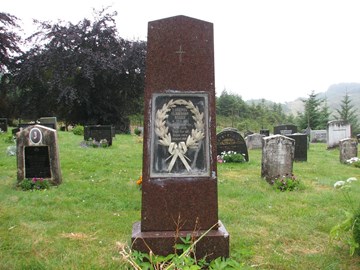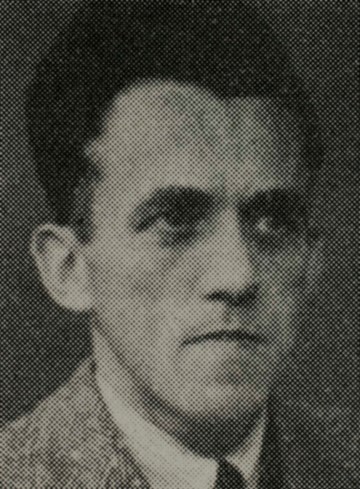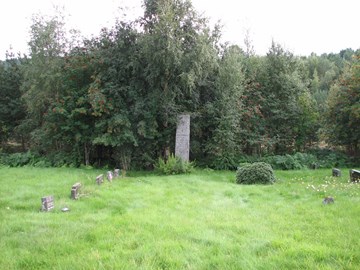


Anna Myklebust (1868-1942) from Bryggja put down an unusually high number of hours for the temperance movement. She established a children's lodge at Bryggja and travelled for many years as a speaker in the Nordfjord region. In 1847, the regional lodge erected a memorial stone on her grave at Totland church.

Engineer and pilot officer Torberg Haaland was one of two from Førde who lost their lives in the service of their country during the Second World War. He was buried in the churchyard in Førde on 11 August, 1945. Some time after this a memorial stone was erected on his grave.

On Friday 19 October, 1945, the Selje church was filled to capacity by village people and others. The occasion was the funeral for Oluf Ingebrigtsen Aarsheim. He lost his life in a war episode in the Atlantic and now his urn had been brought home. Afterwards his siblings erected a memorial stone on his grave.

Nearly 120 000 Americans lost their lives in the First World War, most of these at the front in France. One of them was Lorents Bakke from Bremanger. He emigrated to America in 1911. He returned home as a deceased American soldier in France and was buried on the churchyard at Novelandet.

The former municipality of Bremanger had 13 war victims from the Second World War. Most of these were lost at sea. Only three got a grave at their home place. Arthur Hauge's urn was brought home from England on the destroyer "Arendal" in the autumn of 1945, and the funeral took place from Hauge church on 11 October the same year.

"In a statement from the chief command of the Norwegian Royal Navy he died on his post for the country." These words are written in the death notice of Peder P. Sandvik on 20 August, 1945. Peder Sandvik lost his life during an air raid on London on 7 March, 1945. His ashes were brought home and he was buried in the graveyard of Leikanger church on 21 November the same year.

On 15 April, 1946, the cargo on a motor boat loaded with German ammunition caught fire on her way to a dumping site in Nordfjord. People jumped overboard and everybody but one was saved by boats that came to the rescue. Reidar Drage from Stadlandet was buried at Leikanger church on 20 April, 1946.

In the spring of 1942, 10 Norwegian ships left Gothenburg heading for England. Only two managed to break through the German blockade. Many ships were scuttled (deliberately sunk) by the crew to prevent them from falling into the hands of the Germans. The crews were taken prisoner and ended up in prison camps in Germany. Bernhard Reksten from Flora lost his life in a prison camp in Poland in the spring of 1944. After the war, his urn was brought back home and he was buried in the graveyard at Reksta. Relatives and friends later erected a memorial stone on his grave.

Dagfinn Frøyen escaped to England and served in the merchant marine. While working as a seaman on SS Balduin, he fell ill and died in the spring of 1944. His urn was brought back to Norway on the destroyer "Arendal" in late September 1945. He was buried on 1 October the same year.

Both during and after the war fatal accidents happened when people inadvertently stepped on mines. At Osmundvåg, the 18-year-old Ole Dagfinn Eide died on 18 July, 1946. He stepped on a mine at a place that had been cleared of mines and where the area had been declared safe.

On the oldest part of the churchyard at Norum church there is a somewhat tall, obelisk-shaped memorial stone. The inscription indicates that a student was buried here and that teachers and college friends erected this memorial on his grave.

On 3 February 1940, the SS "Hop" left Bergen for England in ballast. The boat never got there. Three weeks later, the newspaper Firda Folkeblad had a short report with the headline "Bergen ship with 17 men missing." The captain was from Askvoll. Several years passed before the captain's widow had knowledge of what had happened. And she had to find out by herself.

In the summer of 1956, the temperance people in the municipalities of Brekke and Gulen met at Rutledal. There was a special solemn atmosphere that day. A memorial stone for Ivar and Andrine Svardal was unveiled. Svardal founded one of the first temperance organizations in Sogn.

Edvin Færøy lost his life in action in Valdres on 20 April 1940. He was first buried in Valdres but was later moved home and buried on the churchyard at Rutledal. The villagers erected a memorial stone on his grave.

On 29 July, 1910, a German naval officer lost his life when he fell down the mountainside on the south side of the valley of Bøyadalen. His parents, Herr and Frau Christiani from Berlin, came to Fjærland for the funeral, and later made arrangements for raising a memorial stone on his grave.

Martin Luther Storm, born 1836, is one of the most important names in the history of the agricultural schools in the county of Sogn og Fjordane. When the county gave up the school at Mo in 1870, Storm in the spring of 1873 came to Mo as a tenant, and he governed the school until 1907, when the county again took over. He died in the autumn of 1916, and in the summer of 1922, former students donated a memorial stone on this grave at the graveyard in Førde.

"Bread of stone and spirit of 'Striile' (local people), Dahl forced at Eivindvik". These are the frequently quoted words by Henrik Wergeland about the vicar Niels Griis Alstrup Dahl in his poem Eivindvig. They testify to a vicar who was concerned both with the material and spiritual aspects of life. He died in 1852 and was buried at Gulen church. In 2002 - 150 years later - the people of Gulen erected a memorial stone for Dahl.

Augustin Bredvik (1868-1952) was bailiff in Gulen for more than 40 years. "One of the pillars of western Norway" as the newspaper Firda put it in an obituary. On 15 August 1954, a memorial stone was unveiled on his grave at the church at Eivindvik.

Halvard Benjamin Trædal from Indre Oppedal lost his life in action in Valdres on 26 April 1940. He was first buried in Valdres, but his remains were moved home the same autumn. "Oppedal Ungdomslag" immediately took the initiative to raise a memorial stone on his grave, and in the spring of 1941, the stone was unveiled.

The memorial stone on the grave of Anna Cathrine Schreuder, mother of the missionary Hans Schreuder, is found at Stedje church in Sogndal. The idea to erect such a memorial was introduced in 1917 on the centenary of Schreuder¿s birthday. Many people were gathered at Kjørnes on this occasion, but it would take more than ten years before the idea was carried out.

The brothers Ragnvald and Arthur Torheim lost their lives during the Second World War due to war actions. Both brothers are buried in the same grave on the churchyard at Nord-Vågsøy church, and there is a beautiful memorial stone on the grave.

Jon J. Hop was the first person from Solund to lose his life in the war 1940-1945. He was a crew member on a vessel on its way to pick up flour at Vaksdal. The vessel was seized by the Germans and came under fire from Norwegian forces. Jon and several more on board were killed. After the war a memorial stone for Jon J. Hop was erected.

After the mobilization on 9 April 1940, men from the whole county of Sogn og Fjordane mustered at Bømoen at Voss. From 19 April, some 2000 men were transferred east and took part in the Valdres campaign until the capitulation on 30 April. Konrad Byrknes was one of the few who did not make it back home alive. In July 1945, a memorial stone was unveiled on his grave at Mjømna church.

People in the county of Sogn og Fjordane have honoured at least seven persons with memorial stones for their achievements in song and music. Two memorial stones are located in the churchyard at Holmedal, - one on the grave of the teacher and parish clerk Ola Espedal, the other on the grave of Sigurd Fossen.

People in the county of Sogn og Fjordane have honoured at least seven persons with memorial stones for their achievements in song and music. Two memorial stones are in the churchyard at Holmedal, - one on the grave of Sigurd Fossen, the other on the grave of Ola Espedal.

Hans Seip (1881-1945) was county governor in Sogn og Fjordane from 1929 until he was removed from office by the Nazi regime in the summer of 1941. He then moved to Fjærland. In the early weeks of 1945, he fell ill and died on 14 March the same year. Upon his request he was buried in Fjærland. In 1949, the county council erected a memorial stone on his grave.

"Youths erected this stone in gratitude for your loyalty to many good causes". These words are carved into the memorial stone for Ragnar Melvær on the churchyard in Florø, unveiled on 13 June 1920. Melvær died at the young age of 33, in the midst of his work with many "good causes": the liberal youth association, the temperance movement, the "nynorsk" language movement, and the rifle association.